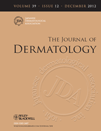Epidemiological aspects of Trichophyton rubrum var. raubitschekii in Japan
Abstract
Trichophyton rubrum var. raubitschekii is a rare anthropophilic dermatophyte isolated around the world from tinea corporis, tinea cruris, tinea pedis and tinea unguium. In this study, the isolation rate of T. rubrum var. raubitschekii was studied in 200 cases of tinea pedis and tinea unguium in Japan. The 200 clinical isolates were shown to be of downy type as their colonies on Sabouraud's dextrose agar were white to cream, suede-like to downy, with a yellow-brown to wine-red reverse, and they produced few macroconidia. The type strain of T. rubrum var. raubitschekii (CBS 100084) and one clinical isolate (KMU 8337; isolated at Kanazawa) of downy type tested positive for urease, but the reference strain of T. rubrum (CBS 392.58) and the remaining 199 clinical isolates tested negative. Further epidemiological investigations are required to study human cases of infection with the granular type of T. rubrum and T. rubrum var. raubitschekii in Japan.




